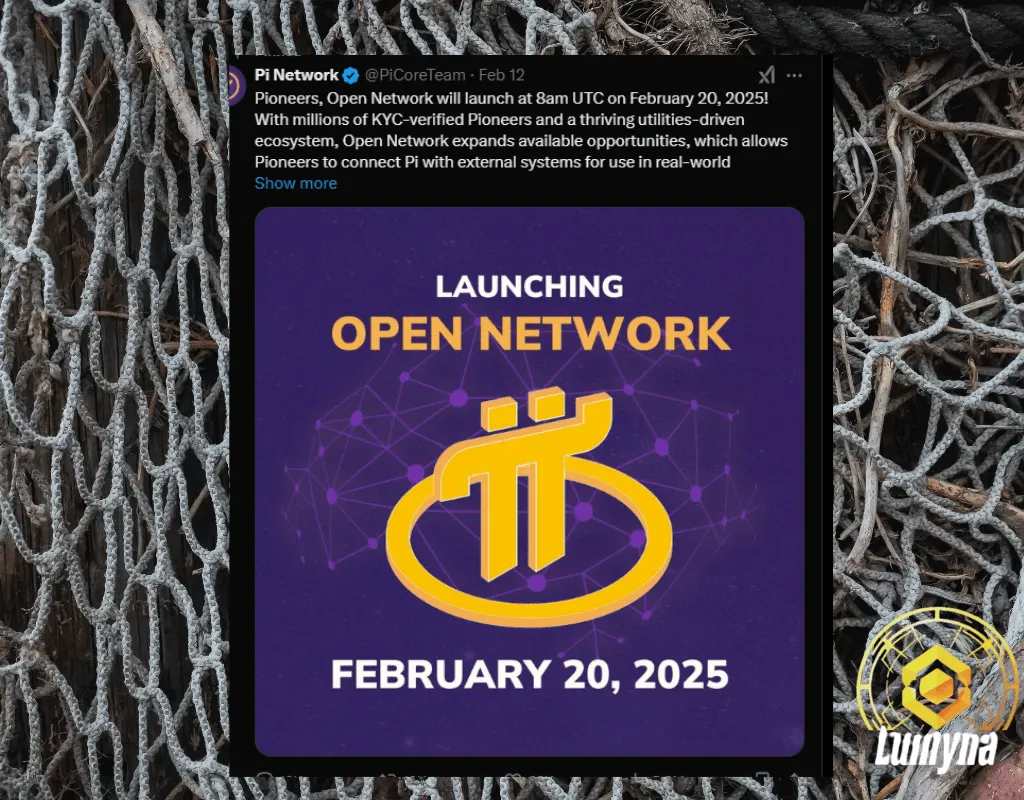The Pi Network mainnet launch on February 20, 2025, is one of the most highly anticipated events in the cryptocurrency space. After years of development, testing, and a closed ecosystem, Pi Network is finally transitioning into an open, decentralized blockchain. This milestone marks a major leap forward for Pi users, known as “Pioneers”, as it enables real-world transactions, exchange listings, and decentralized applications (dApps).
Pi Network, which launched in 2019, was designed to make cryptocurrency mining accessible to everyone using mobile devices instead of expensive, energy-intensive mining hardware. Since then, the project has amassed millions of users worldwide, positioning itself as one of the largest blockchain communities. However, until now, Pi transactions have been restricted to an enclosed mainnet, limiting their use beyond the Pi ecosystem.
With the open mainnet launch, Pi Network will complete its transition to decentralization, allowing for greater interoperability with external platforms. This move will enable several key functionalities:
- External Wallet Transfers: Users can send and receive Pi coins outside the Pi ecosystem.
- Exchange Listings: Major crypto exchanges are expected to list Pi, making it tradeable like other cryptocurrencies.
- dApp Development: Developers can build decentralized applications that integrate with the Pi blockchain.
This launch is a turning point for Pi Network, paving the way for global adoption and mainstream cryptocurrency use. As the ecosystem opens up, excitement is building around Pi’s potential impact on digital finance. Will Pi Network live up to its promises? Let’s explore everything you need to know about this historic event.
What is Pi Network?
Pi Network is a revolutionary cryptocurrency project designed to make crypto mining accessible to the masses. Unlike Bitcoin and other traditional cryptocurrencies that require expensive mining rigs and consume massive amounts of electricity, Pi Network allows users to mine Pi coins directly from their smartphones. This unique approach has attracted millions of users worldwide, positioning Pi as one of the most widely adopted blockchain projects before its official launch.
Background: A Stanford-Initiated Project
Pi Network was founded in 2019 by a team of Stanford University graduates, including Dr. Nicolas Kokkalis and Dr. Chengdiao Fan. Their goal was to democratize access to cryptocurrency by creating a system where anyone with a smartphone could participate in mining and transactions without technical expertise or financial barriers.
Unlike traditional cryptocurrencies, which often favor early adopters with powerful mining setups, Pi Network’s system ensures equal mining opportunities for everyone. This inclusive vision has fueled its rapid expansion and global adoption.
Mission: Making Crypto Mining Accessible via Mobile Devices
One of the main challenges in the cryptocurrency industry is the high entry barrier for new users. Many people find mining complex, expensive, and energy-draining. Pi Network solves this problem by enabling users, known as “Pioneers”, to mine Pi coins using a simple mobile app.
The Pi mining process is:
- User-friendly: No technical knowledge or mining rigs required.
- Energy-efficient: Unlike Bitcoin, which relies on Proof-of-Work (PoW) and consumes vast amounts of energy, Pi Network uses a more sustainable consensus mechanism.
- Mobile-first: Users can mine on their smartphones without significant battery drain or high computing power.
How Pi Network Works: Mobile Mining Instead of Energy-Intensive Processes
Pi Network leverages the Stellar Consensus Protocol (SCP), which allows users to validate transactions through trust-based security circles. This means that instead of solving complex mathematical problems like Bitcoin miners do, Pi miners simply confirm the legitimacy of transactions by interacting with trusted members of the network.
Users mine Pi by:
- Opening the Pi app daily to confirm their participation.
- Earning Pi based on activity and engagement within the network.
- Inviting others to join, which boosts their mining rate.
Growth Through Community Engagement and Referrals
Pi Network has grown exponentially due to its strong community-driven model. The project incentivizes users to invite friends and family, expanding the network organically. This referral-based approach has helped Pi build a global ecosystem of millions of Pioneers, even before the mainnet launch.
With its upcoming open mainnet launch on February 20, 2025, Pi Network is set to take the next step toward real-world adoption, bringing its vision of decentralized, mobile-first cryptocurrency to life.
Pi Network’s Evolution: From Beta to Mainnet
Since its launch in 2019, Pi Network has gone through multiple phases of development, gradually transitioning from an experimental blockchain project to a fully decentralized cryptocurrency ecosystem. The journey from Beta to Open Mainnet has involved rigorous testing, community building, and security enhancements to ensure a stable and scalable platform.
Beta Phase (2019): Early Community Building and Mobile Mining
Pi Network was introduced on March 14, 2019 (Pi Day), marking the beginning of its Beta phase. The goal of this stage was to attract users and test mobile mining as a concept. During this phase:
- The Pi mobile app was launched, allowing users to mine Pi coins by simply tapping a button daily.
- The network grew rapidly as users invited others through referrals, leading to exponential adoption.
- Pi Network’s development team focused on ensuring fair and accessible mining, without energy-intensive Proof-of-Work (PoW) mechanisms.
By the end of 2019, millions of Pioneers had already joined, proving that mobile mining could be a viable alternative to traditional crypto mining.
Testnet Phase (2020): Testing Blockchain Performance
In 2020, Pi Network moved into its Testnet phase, an essential step for any blockchain before mainnet deployment. This phase focused on:
- Launching the first version of the Pi blockchain, allowing developers to test transaction capabilities.
- Onboarding Node operators, enabling users to run Pi Nodes on personal computers to validate transactions.
- Improving network security, ensuring that Pi’s blockchain was resistant to attacks or failures.
By the end of this phase, thousands of Nodes were running Pi Network’s blockchain, preparing it for real-world transactions.
Enclosed Mainnet (2021–Present): Restricted Transactions and KYC Verification
On December 28, 2021, Pi Network launched its Enclosed Mainnet, marking a crucial milestone in its evolution. This phase was designed to:
- Implement KYC (Know Your Customer) verification to prevent fraudulent accounts and bots from mining Pi.
- Allow limited transactions within the Pi ecosystem, enabling Pioneers to spend Pi in Pi-based marketplaces without external exchange listings.
- Continue building Pi applications through its developer platform, encouraging the growth of a real-world utility ecosystem.
During this phase, many users completed KYC verification, preparing their accounts for migration to the Open Mainnet. However, transactions remained enclosed within the network to prevent speculation and unauthorized trading.
Open Mainnet (2025 Launch): Full Decentralization and External Connectivity

With the upcoming Open Mainnet launch on February 20, 2025, Pi Network is set to become a fully functional decentralized cryptocurrency. This transition will introduce:
- External connectivity, allowing Pi holders to send and receive Pi coins outside the enclosed network.
- Wallet transfers, enabling users to store and manage Pi securely in third-party crypto wallets.
- Exchange listings, meaning Pi could be traded on major cryptocurrency exchanges, increasing its liquidity and real-world adoption.
The Open Mainnet launch represents the culmination of years of development and community efforts, positioning Pi Network as a viable, decentralized digital currency with mass adoption potential.
Key Features of the Open Mainnet
The launch of Pi Network’s Open Mainnet on February 20, 2025, marks a significant transition from a restricted, enclosed ecosystem to a fully decentralized and open blockchain network. This shift brings several key functionalities that enhance Pi’s usability, liquidity, and real-world applications. Among the most critical features of the Open Mainnet are external wallet transfers, exchange listings, and the expansion of decentralized applications (dApps).
1. External Wallet Transfers – Move Pi Coins to External Wallets
One of the most anticipated features of the Open Mainnet is the ability to transfer Pi coins to external wallets, making Pi fully compatible with the broader blockchain ecosystem. Previously, Pi transactions were restricted within the enclosed network, but with this upgrade, users can:
- Send and receive Pi across different wallets, including non-custodial crypto wallets.
- Store Pi on decentralized wallets such as MetaMask, Trust Wallet, and Ledger, providing users full control over their assets.
- Use Pi for peer-to-peer (P2P) transactions without limitations, facilitating payments, remittances, and cross-border transactions.
With these enhancements, Pi holders gain true ownership of their coins, aligning Pi Network with other major cryptocurrencies like Bitcoin and Ethereum in terms of financial sovereignty and accessibility.
2. Exchange Listings – Potential Trading on Platforms like Binance, OKX
The Open Mainnet enables Pi to be listed on cryptocurrency exchanges, a crucial step toward increasing its market liquidity and adoption. Exchange listings will allow users to:
- Trade Pi on major platforms such as Binance, OKX, and Coinbase.
- Determine Pi’s market value through open trading, shifting from a community-driven barter system to a price-driven marketplace.
- Attract institutional and retail investors, boosting Pi’s credibility in the crypto space.
For Pi Network, this means integration into the global financial ecosystem, allowing more people to buy, sell, and invest in Pi beyond the Pi community. However, the development team may impose certain restrictions initially to prevent price manipulation and ensure network stability.
3. Decentralized Applications (dApps) – Expanding the Utility of Pi Coins
With the Open Mainnet, Pi Network is not just enabling transactions—it is also expanding the ecosystem through decentralized applications (dApps). This will allow developers to build and launch applications directly on the Pi blockchain, creating real-world use cases. Some potential applications include:
- E-commerce platforms where users can spend Pi for goods and services.
- DeFi (Decentralized Finance) applications, such as lending, staking, and decentralized exchanges.
- Gaming and NFT marketplaces, allowing users to buy, sell, and trade digital assets using Pi.
- Smart contracts, enabling secure, automated agreements without intermediaries.
By fostering dApp development, Pi Network ensures its long-term viability beyond just being a tradable cryptocurrency. Developers and businesses can leverage Pi’s blockchain to create innovative solutions, driving adoption and increasing its real-world value.
Key Takeaway
The Open Mainnet launch brings major advancements to the Pi Network ecosystem. With external wallet support, exchange listings, and dApp integration, Pi transitions into a truly decentralized, functional cryptocurrency. These upgrades provide users with more freedom, security, and opportunities, paving the way for Pi’s mainstream adoption in the crypto world. 🚀
Impact on Price and Market Sentiment
The launch of Pi Network’s Open Mainnet on February 20, 2025, has generated significant speculation and excitement in the crypto community. As Pi transitions from an enclosed system to a fully decentralized and tradable asset, its price and market sentiment are expected to experience notable fluctuations.
1. Speculation and Excitement Leading to Price Surges
Historically, major blockchain upgrades and mainnet launches have led to price surges driven by anticipation and hype. Pi Network is no exception. Several factors contribute to the initial bullish sentiment:
- Increased visibility and investor interest as Pi enters the broader crypto market.
- FOMO (Fear of Missing Out) among traders and speculators looking to capitalize on early price movements.
- Exchange listings, which will enable liquidity and boost demand.
- Mass adoption potential, given Pi’s large user base of over 50 million engaged pioneers.
If demand significantly exceeds supply during the initial trading phase, Pi’s price could experience a rapid upward spike.
2. Potential Market Volatility Post-Launch
Despite early optimism, Pi’s price is likely to face high volatility following the Open Mainnet launch. Some of the key challenges that could impact price stability include:
- Sell-offs by early adopters, who may cash out after years of accumulation.
- Regulatory uncertainties, as different jurisdictions assess Pi’s compliance with financial laws.
- Market corrections, as speculative bubbles often lead to price pullbacks before stabilizing.
- Liquidity and trading volume fluctuations, depending on the number of exchanges listing Pi.
Newly listed cryptocurrencies often experience price swings of 50% or more in their early days of trading, making short-term investment strategies highly risky.
3. Analyst Predictions for Price Trends
Crypto analysts have mixed predictions regarding Pi Network’s long-term price trajectory. Some bullish projections suggest that Pi could reach between $5 to $50 per coin within its first year of open trading, assuming:
- Strong exchange support from platforms like Binance and Coinbase.
- Continuous ecosystem development and dApp adoption.
- A well-balanced supply and demand dynamic.
However, more cautious analysts warn that Pi’s price could face downward pressure if:
- A large number of users flood the market with Pi for quick profits.
- Adoption of Pi for real-world transactions remains slow.
- The project fails to maintain consistent updates and development progress.
Our Take
Pi Network’s Open Mainnet launch will undoubtedly shape its market sentiment and price trajectory. While short-term volatility is expected, long-term success will depend on real-world utility, exchange adoption, and community engagement. Traders and investors should carefully monitor market trends before making investment decisions. 🚀
Ensuring a Secure and Compliant Transition
The launch of Pi Network’s Open Mainnet on February 20, 2025, marks a crucial step in its journey toward decentralization. However, ensuring a secure and compliant transition is essential for the network’s long-term success. Two key aspects of this transition are KYC verification and node migration, both of which play a critical role in protecting the network’s integrity and functionality.
1. KYC Verification – Strengthening Security and Legitimacy
Know Your Customer (KYC) verification has been a fundamental requirement in Pi Network’s transition to Open Mainnet. Millions of Pi users have undergone identity verification to ensure a secure and trusted ecosystem. The KYC process helps:
- Prevent fraudulent activities by ensuring that each user is a real individual, reducing the risk of bots and duplicate accounts.
- Comply with global regulations, which is essential for listing Pi on major exchanges and facilitating mainstream adoption.
- Enable secure transactions, ensuring that only verified users can transfer Pi coins on the open network.
Pi Network uses a decentralized KYC solution, leveraging AI-driven identity verification combined with community validation. This approach ensures a scalable and cost-effective method for verifying millions of users worldwide.
As the Open Mainnet goes live, KYC remains a prerequisite for participating in external wallet transfers, dApp interactions, and future exchange listings. Users who fail to complete KYC will have restricted access to Pi’s full functionalities, reinforcing the need for compliance.
2. Node Migration – Transitioning from Testnet to Mainnet
Pi Network operates on a decentralized infrastructure where nodes play a crucial role in validating transactions and securing the blockchain. The transition from Testnet to Mainnet involves migrating nodes to the live network, ensuring:
- Decentralization – A strong and diverse network of nodes reduces reliance on centralized authority.
- Scalability – Efficient node deployment ensures Pi’s blockchain can handle increased transaction volumes.
- Security – A properly transitioned node network prevents vulnerabilities and protects against cyber threats.
The migration process requires node operators to update their software, sync with the new blockchain, and participate in consensus mechanisms to validate transactions. The Pi Core Team has provided technical guidance to node operators, ensuring a smooth transition with minimal disruptions.
Final Take
By enforcing KYC verification and facilitating seamless node migration, Pi Network is prioritizing security, compliance, and decentralization. These steps will strengthen the ecosystem, ensuring a stable and sustainable transition to the Open Mainnet era.
How to Sell Pi Coin After the Open Mainnet Launch
With the Pi Network Open Mainnet launching on February 20, 2025, many pioneers are eager to sell their Pi coins and realize their value. However, selling Pi requires a step-by-step approach, ensuring users comply with security measures and use trusted exchanges. Below is a detailed guide on how to sell Pi coin after the Open Mainnet launch.
Step 1: Complete KYC and Migrate Pi Coins
Before selling Pi, users must complete Know Your Customer (KYC) verification and migrate their Pi coins from the Enclosed Mainnet to the Open Mainnet. Without KYC, access to external transfers and exchange listings will be restricted.
- KYC Process: Users should ensure they have submitted identity verification via the Pi Network app. This process helps prevent fraud and ensures regulatory compliance.
- Migration Process: Once KYC is verified, users can migrate their Pi balance to the Open Mainnet. This step allows them to transfer coins freely, making them eligible for exchange deposits.
Users can check their KYC and migration status in the Pi Network app under the “Mainnet Checklist” section.
Step 2: Choose a Reliable Exchange
Once Pi coins are migrated, the next step is selecting a trusted crypto exchange that supports Pi trading. Some potential platforms that may list Pi include:
- OKX – A top-tier exchange with strong liquidity and global reach.
- MEXC – Known for supporting emerging cryptocurrencies.
- Bitget – A growing exchange offering low trading fees.
- HTX (Huobi) – A well-established platform with high trading volume.
Choosing the right exchange depends on factors like liquidity, withdrawal fees, security, and user experience. Pioneers should check official Pi Network announcements to confirm exchange listings.
Step 3: Transfer Pi Coins to an Exchange Wallet
After selecting an exchange, users must transfer Pi coins from their Pi Network Wallet to the exchange’s deposit wallet. Here’s how:
- Log into the exchange and navigate to the deposit section.
- Select Pi (LMY) as the deposit currency and generate a wallet address.
- Copy the exchange wallet address and open the Pi Network Wallet.
- Initiate a transfer by pasting the exchange wallet address and specifying the amount.
- Confirm the transaction and wait for blockchain confirmation.
Transfers may take a few minutes to several hours, depending on network congestion and exchange processing times.
Step 4: Place a Sell Order (Market Order vs. Limit Order)
Once Pi coins reach the exchange wallet, users must place a sell order to convert Pi into USDT, BTC, or fiat currency.
- Market Order: Executes immediately at the current market price. Ideal for those who want an instant sale but may get a slightly lower price.
- Limit Order: Allows users to set a specific selling price. The order executes only when the market reaches that price. Best for maximizing profits but requires patience.
To place a sell order:
- Go to the trading section of the exchange.
- Select the Pi/USDT or Pi/BTC trading pair.
- Choose Market or Limit order.
- Enter the amount of Pi to sell.
- Confirm the trade and wait for execution.
Step 5: Withdraw Funds to Fiat or Crypto Wallet
After selling Pi, users can withdraw their funds in fiat (USD, EUR, etc.) or other cryptocurrencies. The process varies based on the exchange:
- Fiat Withdrawal: Convert Pi to USDT or BTC, then withdraw to a bank account or PayPal (if supported).
- Crypto Withdrawal: Transfer funds to an external wallet like MetaMask, Trust Wallet, or Ledger for safekeeping.
Users should check withdrawal limits and fees before making transactions.
Step 6: Monitor the Market for Price Trends
Pi’s value may fluctuate significantly post-mainnet launch. To maximize returns, users should:
- Track price movements on exchanges and crypto market trackers like CoinMarketCap.
- Analyze market trends, considering factors like supply, demand, and news updates.
- Be cautious of volatility, as early-stage cryptocurrencies experience rapid price swings.
Some investors may hold Pi for long-term growth, while others may trade actively based on market conditions.
Final Thoughts
Selling Pi coins after the Open Mainnet launch requires careful planning and execution. By completing KYC, selecting a reliable exchange, transferring funds securely, and monitoring the market, users can sell Pi efficiently and maximize their returns.
With increasing adoption and exchange listings, Pi Network’s true market value will be determined in the coming months. Whether selling or holding, pioneers should stay informed and make decisions based on market conditions and personal financial goals. 🚀
Potential Benefits of the Pi Network Mainnet Launch
The launch of the Pi Network Open Mainnet on February 20, 2025, marks a significant milestone in the project’s evolution. This transition unlocks a range of benefits for everyday users, developers, and entrepreneurs, enhancing accessibility, financial inclusion, and ecosystem growth.
For Everyday Users
1. Accessibility Through Mobile Mining
Unlike traditional cryptocurrencies like Bitcoin and Ethereum, which require powerful mining rigs, Pi Network enables users to mine Pi coins using mobile devices. This feature has made crypto mining more accessible to millions of users worldwide. With the Open Mainnet, users can now transfer, trade, and utilize Pi coins, increasing their real-world value.
2. Financial Inclusion for Underbanked Regions
Many people in developing countries lack access to traditional banking systems. Pi Network aims to bridge this gap by offering a mobile-based financial alternative. The Open Mainnet allows users to:
- Send and receive payments instantly without relying on banks.
- Use Pi coins for purchases in marketplaces that accept Pi as payment.
- Store value securely in a decentralized, censorship-resistant network.
By providing a low-cost, decentralized financial solution, Pi Network promotes economic empowerment in underbanked regions.
For Developers & Entrepreneurs
1. dApp Development Opportunities
With the launch of the Open Mainnet, developers can build and deploy decentralized applications (dApps) on the Pi Network blockchain. This creates new opportunities for:
- Blockchain-based services, such as decentralized finance (DeFi) apps, NFT platforms, and peer-to-peer marketplaces.
- Smart contract execution, allowing automated and trustless transactions.
- In-app transactions using Pi, enabling digital payments in gaming, e-commerce, and content platforms.
The growth of the Pi ecosystem will attract developers looking to innovate and leverage a ready-made user base of millions.
2. Growth of the Pi Network Ecosystem
The Open Mainnet will expand Pi’s utility beyond mining, driving adoption and ecosystem development. As businesses integrate Pi payments and more dApps emerge, the network will gain mainstream appeal. Entrepreneurs can:
- Create Pi-based online businesses that accept Pi coins as payment.
- Offer services within the Pi ecosystem, such as exchanges, lending platforms, and investment tools.
- Leverage Pi’s global user base to drive adoption and scale their projects faster.
With new economic opportunities emerging, the Pi Network’s Open Mainnet could revolutionize how people earn, spend, and invest in digital assets. 🚀
Criticisms and Challenges of the Pi Network
While the Pi Network Open Mainnet launch is a highly anticipated event, the project has faced significant criticisms and challenges over the years. These concerns range from its referral-based mining model to regulatory scrutiny and technical delays. Addressing these issues will be crucial for Pi Network’s long-term success and credibility.
1. Pyramid Scheme Allegations – Referral Model Concerns
One of the most persistent criticisms of Pi Network is that it resembles a pyramid scheme due to its referral-based mining system. Unlike Bitcoin or Ethereum, where mining is based on computational work, Pi users earn rewards by inviting new users to the network. Critics argue that:
- The reward structure incentivizes user growth rather than blockchain utility.
- Early adopters accumulate more Pi coins, potentially leading to wealth concentration.
- If new users stop joining, the mining rate declines, raising concerns about sustainability.
However, Pi Network’s team maintains that the referral system was designed to promote adoption, not as a multi-level marketing (MLM) scheme. With the Open Mainnet, users will finally be able to trade and use Pi, potentially reducing skepticism.
2. Limited Real-World Utility – Uncertainty Around Adoption
Despite having millions of users, Pi Network has struggled to establish real-world use cases beyond its enclosed ecosystem. Critics argue that:
- Few merchants accept Pi as a payment method.
- There are no major partnerships with businesses or financial institutions.
- Without broad adoption, Pi risks becoming a speculative asset rather than a functional cryptocurrency.
To address this, Pi Network must expand its utility by encouraging merchant adoption, integrating with decentralized applications (dApps), and fostering an active developer community. The Open Mainnet will be a crucial test for whether Pi can transition from a theoretical project to a practical digital currency.
3. Transparency and Regulatory Concerns – Development Process Scrutiny
Since its launch in 2019, Pi Network has faced accusations of lacking transparency in its development and business model. Key concerns include:
- Lack of open-source blockchain code, making it difficult to verify how Pi functions.
- No clear roadmap on how Pi Network plans to ensure compliance with financial regulations.
- Uncertainty about leadership decisions, with limited communication from the core team.
Additionally, regulatory agencies in some countries may classify Pi as a security rather than a cryptocurrency, potentially leading to legal restrictions. To build trust, Pi Network must enhance transparency, release open-source code, and clarify regulatory compliance efforts.
4. Technical Delays and Uncertainty – Past Delays Affecting Confidence
Pi Network has repeatedly postponed its Open Mainnet launch, causing frustration among users. Initially expected in 2022, the transition to a fully decentralized blockchain has taken longer than anticipated. Challenges include:
- Delays in KYC verification, slowing down migration to the mainnet.
- Security and scalability concerns, requiring extended test phases.
- Lack of communication on progress, leading to speculation about the project’s viability.
While the February 2025 launch aims to resolve these issues, Pi Network must deliver on its promises to regain trust. Ensuring a smooth mainnet transition, enabling external transactions, and securing exchange listings will be critical for its long-term success.
Pi Network’s Open Mainnet launch is an opportunity to silence critics and prove its real-world value. However, addressing these challenges head-on will determine whether Pi can transition from controversy to credibility in the crypto industry. 🚀
Conclusion: The Future of Pi Network After Mainnet Launch
The Pi Network Open Mainnet launch marks a significant milestone in the evolution of digital finance. After years of development, testing, and anticipation, Pi is finally transitioning from an enclosed ecosystem to a fully decentralized blockchain, enabling external transactions and potential exchange listings. This shift not only validates the project’s vision but also opens new opportunities for users, developers, and investors.
A New Era for Cryptocurrency Adoption and Mining
One of the key promises of Pi Network is revolutionizing cryptocurrency mining. Unlike Bitcoin and Ethereum, which require expensive hardware and high energy consumption, Pi enables users to mine on mobile devices with minimal resources. This innovation could:
- Democratize crypto participation, allowing millions of users to engage in blockchain technology.
- Increase financial inclusion, particularly in underbanked regions where access to traditional banking is limited.
- Encourage mainstream adoption, as more users gain exposure to digital assets without complex mining setups.
If Pi Network successfully builds a vibrant ecosystem, it has the potential to become a leading force in crypto adoption, similar to how Bitcoin pioneered decentralized finance.
The Role of KYC Verification and Market Awareness
With the Open Mainnet, KYC verification remains a crucial step for users. Completing KYC ensures:
- Legitimacy of transactions – Preventing fraud and ensuring compliance.
- Seamless migration of Pi coins – Unverified users may struggle to access full functionalities.
- Regulatory compliance – Strengthening Pi Network’s position in global markets.
Additionally, users must stay informed about market conditions, especially as Pi becomes tradable on exchanges. Market volatility is expected in the early stages, and understanding buying, selling, and holding strategies will be essential for those looking to profit or use Pi for transactions.
Final Thoughts: The Road Ahead for Pi Network
The success of Pi Network post-mainnet depends on several key factors:
- Exchange Listings – Widespread trading options will drive adoption.
- Merchant & dApp Integration – More businesses accepting Pi will enhance its real-world utility.
- Community Engagement – Active participation will sustain network growth.
While skepticism remains, the Open Mainnet launch is a defining moment. If Pi Network can deliver on its promises, it could reshape the crypto landscape and introduce a new model of digital finance. However, execution will be critical—the next few months will determine whether Pi is a game-changer or just another experiment. 🚀



